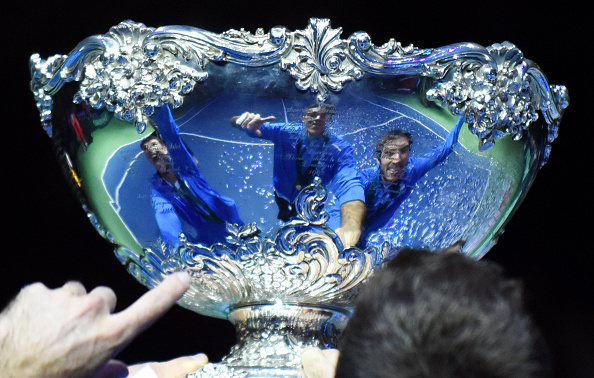Bill Simons
“Playing Davis Cup was an obsession. Everything else, even tournaments, took second place.” – Australian Adrian Quist
The Davis Cup is a gorgeous trophy made of 217 troy ounces of silver. And now the competition for what we feel is the loveliest silver chalice in sports is coming to the “Silver State,” Nevada, and the “Silver City,” Reno, which surged after the Comstock Lode was discovered southeast of town in 1859.
For over a century there’s been little in tennis that’s exceeded the frenzy and excitement of Davis Cup battles – raw, unfiltered, close to the people and loud. Heritage and tradition matter.
Around the world it goes by many names. Call it the Copa Davis or Tazza Davis. Bud Collins dubbed it “Dwight’s pot,” in honor of the Davis Cup’s founder, Dwight Davis, the Harvard student who went on to become Calvin Coolidge’s Secretary of War.
The Davis Cup has been played at Wimbledon, Forest Hills, a small Kazakhstan club and on a Rotterdam pier. We’ve watched it in a leaky hockey arena in Zimbabwe and in a vast soccer stadium in Seville with 27,000 Spaniards shouting at the top of their lungs. It’s been played on seashells, cow dung, assorted carpets, soft green grass in Palm Springs and by the sea in La Jolla. And, despite many a bump in its long road, it remains, with the Laver Cup, the most prominent annual team competition in sports.
On March 4-5, the Reno Events Center, right next to the Silver Legacy Hotel, will host the Colombia vs. US Davis Cup battle. Captain Mardy Fish’s US team, which lost to Colombia in Italy last November, will be led by our top player, world No. 20 Taylor Fritz, No. 38 Sebastian Korda, who is making his Davis Cup debut, Tommy Paul and doubles aces Jack Sock and Rajeev Ram.
The Davis Cup is in a world of its own. For starters, it has its own language. Competitions between teams are called “ties.” A match is “a rubber.” And (follow us here) if a best-of-five tie has already been decided, the match is called “a dead rubber.”
For decades, little was done to change its problematic format. As far back as 1927, Bill Tilden said it should be streamlined. Critics howled that tennis superstars didn’t show up regularly, even though the Davis Cup has provided big stages for lesser known players to shine and become national heroes.
In 2019 there was a radical, sometimes confusing, big-money remake. Some claimed it was an overcorrection. The move left the Davis Cup, to a significant degree, in the hands of a wealthy Spanish soccer star, who sought to rename it the World Cup of Tennis. The appealing home and away matches were diminished.
The last time the Davis Cup Finals were staged, in 2019 and 2021, they were played in Madrid and could hardly be seen on North American TV. Russia won in 2021. But now, Russia and Belarus have been banned by the ITF from playing the Davis Cup and other international events.
Then again, politics and the Davis Cup are hardly strangers. In 1937 Adolph Hitler telephoned German Gottfried Von Cramm to wish him luck before he faced American Don Budge. During the Cold War, Czechoslovakia’s Jan Kodes said, “We have to win. Our country will not allow us to lose to the Russians.”
In 1972, also amid Cold War tensions, Americans Stan Smith and Erik van Dillen overcame blatant cheating and outlandish stalling to down Romanians Ilie Nastase and Ion Tiriac, who US captain Dennis Ralston said should be banned from tennis for life.
South African apartheid prompted India to pull out of the 1974 final and there was a messy 1977 anti-apartheid protest in Newport Beach, where tar was dumped on the court and ten were arrested. And Israel has often stirred controversy.
All the while, the Davis Cup arouses unvarnished passions. Aussie Pat Rafter confided, “I think about Davis Cup even in the shower.” Brit Mark Cox said, “No amount of money can compensate for the loss of ego from a poor Davis Cup experience.”
Young Andre Agassi told us, “There are two things I live by: No. 1, you can never drive too far for Taco Bell. No. 2, You can never beat somebody too bad in Davis Cup.” Once he buzzed a Davis Cup stadium with his private plane.
Players have spit at each other. Yannick Noah went into the stands to go after an outrageous fan. Ecuador’s triumphant Davis Cup captain broke his leg while trying to leap the net in celebration. In Zimbabwe, a fan held up a sign: “Hi, Mom. Send diesel.”
Players have been tossed in the air in triumph and danced in ecstatic conga lines after victories or suffered devastation after humiliating defeats at 2 AM in virtually empty stadiums.
Jimmy Connors sued Arthur Ashe in part because the Davis Cup captain suggested that Connors wasn’t patriotic because he didn’t play for the US.
Now, the US team is coming to high altitude Reno, a city that isn’t exactly known as a tennis mecca. The US has many a star in the world’s top 100. Colombia has a fabulous doubles team, Juan Sebastian Cabal and Robert Farah,
but the average ranking of their singles players is 398. While, with 32 wins, the US remains the most successful Davis Cup nation ever, there’s a long history of Latin American teams who’ve relished taking down Uncle Sam.
After all, David does enjoy toppling mighty Goliath. But American fans in Reno will hope their team prevails to become one of the 12 to emerge out of the qualifying round to reach the finals that are slated for November, in a city that has not been determined as yet.




















